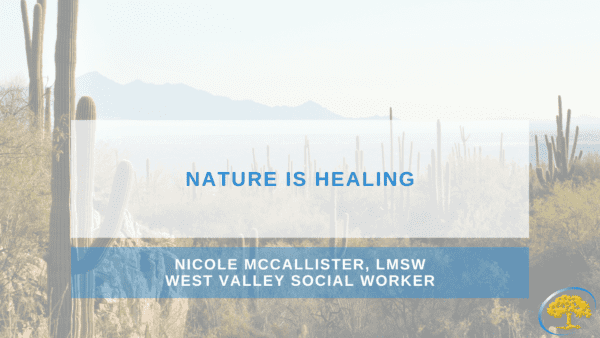
Posted 1 year ago
Nature is Healing
Arizona’s weather is at its finest in the month of March. This is a time for us to get outside and enjoy some nature. Research reveals that environments can increase or reduce our stress, which in turn impacts our bodies. There is a connection between our mind and physical bodies.
All of you on this cancer journey, whether you are a patient or caregiver, are likely to experience stress, anxiety, or a significant feeling of being overwhelmed. Whether you are visiting a doctor’s office for a follow up or receiving an infusion, these appointments can trigger negative feelings or anxiety. The cost of treatment is also reported as one of the top triggers for stress for cancer patients.
The natural environment can generate many positive emotions such as joy, creativity, a sense of calm, and can improve our ability to concentrate. Nature connectedness is associated with lower levels of poor mental health, particularly depression and anxiety.
There are three main ways to experience nature: viewing nature, being surrounded by nature, and active involvement with nature.
Being in nature, or even viewing scenes of nature, reduces anger, fear, and stress and increases pleasant feelings. Exposure to nature not only makes you feel better emotionally, but it also contributes to your physical wellbeing, reducing blood pressure, heart rate, muscle tension, and the production of stress hormones.
“Nature deprivation” a lack of time in the natural world, largely due to hours spent in front of TV or computer screens, has been associated with depression. Across the world, we experienced this in 2020 due to the COVID pandemic and initial recommendations to stay home and isolate. The risks are even higher for developing depression when you are isolation. In a 2011 study published in the Journal of the American College of Cardiology, time in front of a screen was associated with a higher risk of death. That statistic did not change with the implementation of physical activity.
Nature-based interventions (NBI) have been shown to have positive effects on physical, psychological, social, and spiritual health with cancer patients, survivors, and caregivers. In February 2023, the National Institute of Health (NIH) published a study that included over 2700 cancer survivors. Results showed improvements in anxiety, depression, sleep, connectedness, stress, tension, confusion, fatigue, and pain. Participants reported that nature was the most important resource in coping with their cancer. Nature was found to be most beneficial for cancer survivors while they experienced cancer diagnosis and treatment.
So nature is good for us…but how to we experience it?
Here are a few easy ways to begin:
1. Go outside. The easiest way to see nature in your environment is to be a part of it
2. Grow a garden in your yard, on your patio, or maintain potted plants indoors
3. Listen to the sounds of nature on your phone or tv
4. Post wall art or décor of your favorite animals, plants, or nature scenes
5. Collect natural materials. For example, leaves, flowers, feathers, tree bark or seeds. Use them to decorate your living space or in art projects.
6. Eat a meal outdoors either at home or a picnic in the park
7. Journey outside at night and watch the stars. If you are able to drive, you can escape the city haze and experience an abundance of clear, sparkling stars
8. Visit animals – there are 8 zoos and aquariums in Arizona, including Bearizona, just outside of Flagstaff. Here you can experience bears frolicking in the snow while you remain in the safety of your car
One new and trendy way of experiencing nature I recently learned about is forest bathing. Forest bathing is not just for the wilderness-lover; the practice can be as simple as walking in any natural environment and consciously connecting with what’s around you. Live in the city? No problem! Trying walking in your neighborhood green belt or a city park. If you can only manage the sidewalk on your street, focus on the nature you see such as plants, trees, birds, animals, etc.
Take a Rainbow Walk. Bring a notepad, camera, or phone with a camera. Walk at your leisure and look for things that are all the colors of the rainbow. Maybe you find a beautiful red, cactus flower. An abundant ripe orange on a citrus tree may catch your eye. It might be possible to spot a yellow, American Goldfinch on your walk. I often am drawn to the green palm leaves of a tree and the pattern in which they spray out from the trunk. We all know, that 360 days a year in Arizona, you can stare up at the blue perfection in the sky. What will you find that is purple? Take a picture, draw a sketch, or even make a note in your journal of all the things you see in nature that correlate with the rainbow of colors. You can do this walk alone, or you can bring a friend, even a pet.
Are you unable to physically go outside right now? That is okay. There are still ways you can experience nature without leaving the safety and comfort of your home.
Childrenandnature.org is a great resource for finding ways to experience and benefit from nature. They had the following suggestions for those of you at home.
1. Set up a world-watching window- Enjoy moon watching, stargazing, birdwatching and more, from inside your home. Keep a notebook or even binoculars handy to track your nature experiences
2. Take up cloudspotting – Observe the different patterns and kinds of clouds. Cloudspotting is available to anyone, and it’s great for a child or adult in a hospital bed, or for someone with a disability that prevents them from going outdoors. Recommended book: “The Cloudspotter’s Guide” (TarcherPerigee)
3. Keep a journal next to your window – Paint or draw the life and natural elements you see beyond the glass. Suggested book: “The Nature Connection” (Storey Publishing)
4. Start a windowsill garden – See all of the amazing things you can grow right in your window frame
5. Learn to love insects – invest in an ant farm, raise a praying mantis, or keep insect eating plants inside of your home
6. Go on YouTube and explore millions of nature videos. Try choosing one new video a day to increase your knowledge and exposure to nature across this great planet
If you are looking for ways to reduce anxiety, stress, or improve your overall wellbeing during your cancer journey, look no further than our Supportive Care Services team at Ironwood. If you are interested in talking with one of our Social Workers, Genetics Counselors, Registered Dietitians, or our Integrative MD, Dr. Heidi Rula, you can contact us at wellness@ironwoodcrc.om or by calling 480-314-6670.
Nicole McCallister, LMSW
Nicole McCallister is a Licensed Master Social Worker. Nicole received her Master’s in Social Work from Arizona State University in August 2017. She received her Bachelor’s in Criminal Justice Studies in April 2003 from Grand Valley State University in Grand Rapids, MI.
Nicole has spent the last 15 years working with children and families in the child welfare system of Arizona. She completed a social work internship with Ironwood under the supervision of Kelly Huey from August 2016 through May 2017.
Nicole has volunteered with Ironwood’s breast cancer support group in Scottsdale after her internship was complete. Nicole is looking forward to working with cancer patients and their families in hopes of supporting the positive change to those in need.

